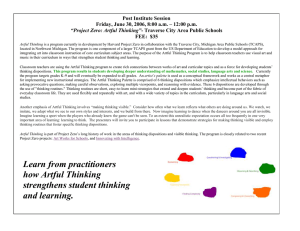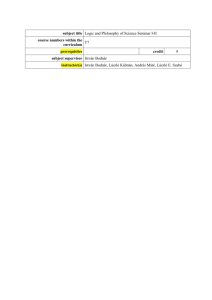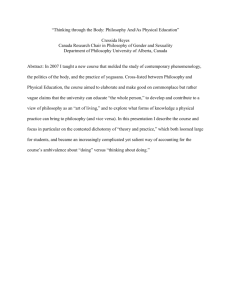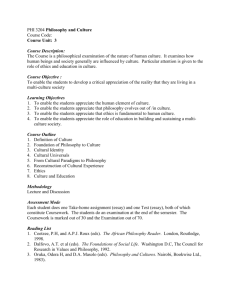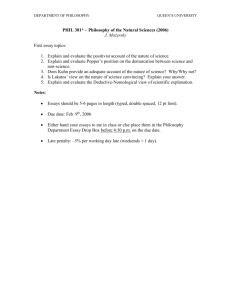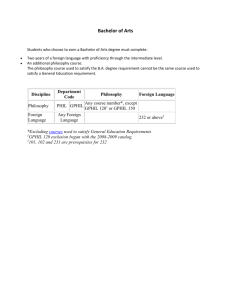Handout: Artful Thinking
advertisement
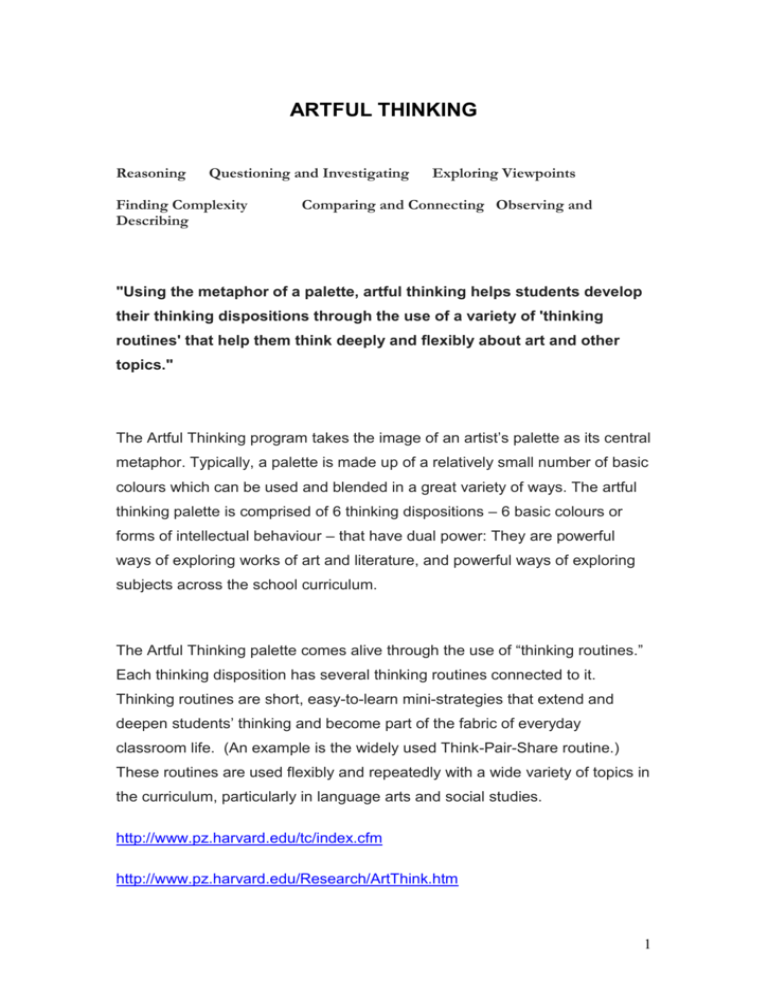
ARTFUL THINKING Reasoning Questioning and Investigating Finding Complexity Describing Exploring Viewpoints Comparing and Connecting Observing and "Using the metaphor of a palette, artful thinking helps students develop their thinking dispositions through the use of a variety of 'thinking routines' that help them think deeply and flexibly about art and other topics." The Artful Thinking program takes the image of an artist’s palette as its central metaphor. Typically, a palette is made up of a relatively small number of basic colours which can be used and blended in a great variety of ways. The artful thinking palette is comprised of 6 thinking dispositions – 6 basic colours or forms of intellectual behaviour – that have dual power: They are powerful ways of exploring works of art and literature, and powerful ways of exploring subjects across the school curriculum. The Artful Thinking palette comes alive through the use of “thinking routines.” Each thinking disposition has several thinking routines connected to it. Thinking routines are short, easy-to-learn mini-strategies that extend and deepen students’ thinking and become part of the fabric of everyday classroom life. (An example is the widely used Think-Pair-Share routine.) These routines are used flexibly and repeatedly with a wide variety of topics in the curriculum, particularly in language arts and social studies. http://www.pz.harvard.edu/tc/index.cfm http://www.pz.harvard.edu/Research/ArtThink.htm 1 Thinking Dispositions What can the character see? What might the character know about or believe? What might the character care about? Reasoning Questioning Viewpoints Why do you say that? What questions does this raise for you? What does it make you want to explore? What would happen if…? Why? Observing Say what happens. Select an important moment. Give an interpretation. Key Aims Develop Critical Thinking Comparing Connecting What’s familiar in this? What’s new in this? What’s challenging in this? Finding Complexity What is exciting about this character or text? What worries or bothers you about this character or text? Nurture Creative Elaboration Encourage Reflection. What else do you need to know or find out to help you make a judgement on this character or text? What’s your current opinion on this character or text? 2 Academic references for Critical Thinking Bailin, S., Case, R., Coombs, J.R. & Daniels, L.B. (1999) Conceptualizing critical thinking, Journal of Curriculum Studies, 31: 285-302. Bailin, S. & Siegel, H. (2003) Critical thinking, in: N. Blake, P. Smeyers, R. Smith & P. Standish (Eds) The Blackwell Guide To The Philosophy Of Education (Oxford, UK, Blackwell Publish). Belenky, M.E., Clinchy, B.M., Goldberger, N.R. & Tarule, J.M. (1986) Women's Ways Of Knowing (New York, Basic Books). Burbules, N.C. (1991) Two perspectives on reasons as an educational aim: The virtues of reasonableness, in: M. Buchmann & R.E. Floden (Eds) Philosophy Of Education 1991: proceedings of the 47th annual meeting of the Philosophy of Education Society (Urbana-Champaign, IL, Philosophy of Education Society, University of Illinois). Burbules, N.C. (1993) Rethinking rationality: the importance of being reasonable, in: A. Thompson (Ed) Philosophy of Education, 1993 (Urbana, Illinois, Philosophy of Education Society. http://www.ed.uiuc.edu/EPS/PES-Yearbook/93_docs/BURBULES.HTM). Ennis, R.H. (1987) A taxonomy of critical thinking dispositions and abilities, in: R. Sternberg & J.B. Baron (Eds) Teaching Thinking Skills: theory and practice (New York, W.H. Freeman). Finkel, D.L. & Monk, S.G. (1978) Contexts for Learning: a teacher's guide to the design of intellectual experience (Olympia, Washington, Evergreen State College). Finkel, D.L. & Monk, S.G. (1983) Teaching and learning in groups: dissolution of the Atlas complex, in: C. Bouton & R.Y. Garth (Eds) Learning in Groups (New Directions for Teaching and Learning No. 14. San Francisco, CA, Jossey-Bass). Foundation for Critical Thinking (1997) Critical Thinking: basic theory and instructional structures (Dillon Beach, CA, Author). Freire, P. (1970) Cultural Action for Freedom (Harvard Educational Review Monograph Series No. 1. Cambridge, MA, Harvard Education Publishing Group). Freire, P. (1973) Education for Critical Consciousness (New York, Seabury Press). Gardner, D.P. (1983) A Nation at Risk: the imperative for educational reform. An open letter to the American people (Washington, DC, National Commission on Excellence in Education). Giroux, H.A. (1994) Toward a pedagogy of critical thinking, in: K.S. Walters (Ed) Re-thinking Reason: new perspectives in critical thinking (New York, SUNY). Gregory, M.R. (2002) Constructivism, standards, and the classroom community of inquiry, Educational Theory, 52: 397-408. Halpern, D.F. (1996) Thought and Knowledge: an introduction to critical thinking (Mahwah, NJ, Erlbaum). Kaplan, L.D. (1991) Teaching intellectual autonomy: The failure of the critical thinking movement, Educational Theory, 41: 361-370. Kurfiss, J.G. (1988) Critical Thinking: theory, research, practice, and possibilities, ASHE-ERIC Higher Education Report No. 2. (Washington, DC, Association for the Study of Higher Education). 3 Lipman, M. (1988) Critical thinking: What can it be? Educational Leadership, 46(1), pp. 38-43. Lipman, M. (1989) Misconceptions in Teaching for Critical Thinking (Resource Publication, Series 2 No. 3 (Upper Montclair, NJ, Institute for Critical Thinking, Montclair State College). Lipman, M. (2003) Thinking in Education (New York, Cambridge University Press). McLaren, P. (1994) Forward: Critical thinking as a political project, in: Kerry S. Walters (Ed) Rethinking Reason: new perspectives in critical thinking (Albany, State University of New York Press). Michelli, N., Pines, R. & Oxman-Michelli, W. (1990) Collaboration for Critical Thinking in Teacher Education: the Montclair State College model (Upper Montclair, NJ, Institute for Critical Thinking Resource Publication Series 3 No.3). Mullis, I.V.S. & Mead, N. (1983) How well can students read and write? (Issuegram 9. Denver, CO, Education Commission of the States (ED 234 352)). Paul, R.W. (1984) Critical thinking: fundamental to education for a free society, Educational Leadership, 42(1), pp. 4-14. Paul, R.W. (1987) Dialogical thinking: critical thought essential to the acquisition of rational knowledge and passions, in: J.B. Baron & R.J. Sternberg (Eds) Teaching Thinking Skills: theory and practice (New York, W.H. Freeman and Company). Paul, R.W. (1992) Critical thinking: What, why, and how, New Directions for Community Colleges, 20: 3-24. Paul, R.W. (1995) Critical Thinking: how to prepare students for a rapidly changing world (Dillon Beach, CA, Foundation for Critical Thinking). Paul, R.W. & Elder, L. (2001) Critical Thinking: tools for taking charge of your learning and your life (Upper Saddle River, NJ., Prentice Hall). Shor, I. (1992) Empowering Education: critical teaching for social change (Chicago, University of Chicago Press). Siegel, H. (1988) Educating Reason: rationality, critical thinking, and education (New York, Routledge Chapman & Hall). Siegel, H. (1995) Why should educators care about argumentation, Informal Logic, 17: 159-176. Thayer-Bacon, B. (1993) Caring and its relationship to critical thinking, Educational Theory, 43: 323-340. Veugelers, W. (2000) Different ways of teaching values, Educational Review, 52: 37-46. Vygotsky, L.S. (1962) Thought and Language (New York, Wiley). 4
